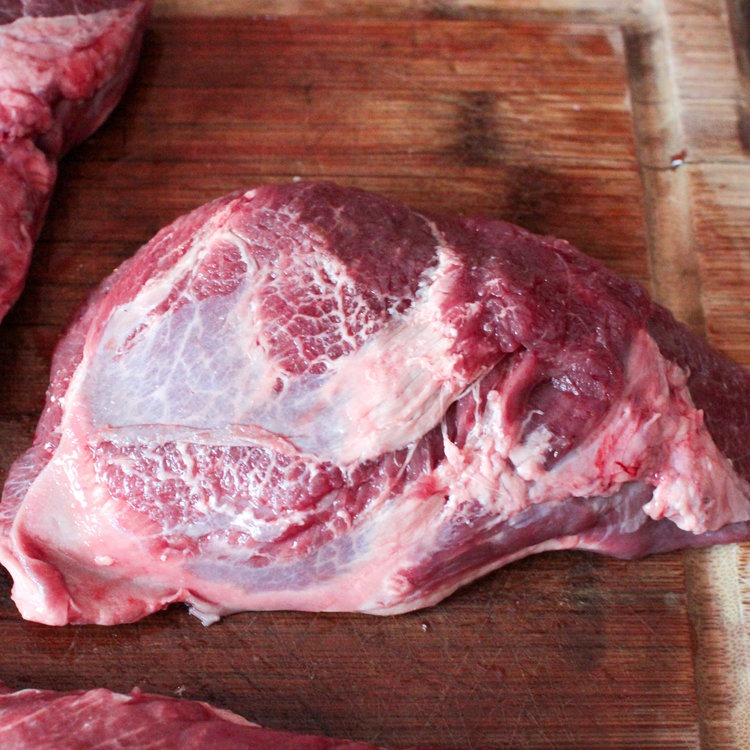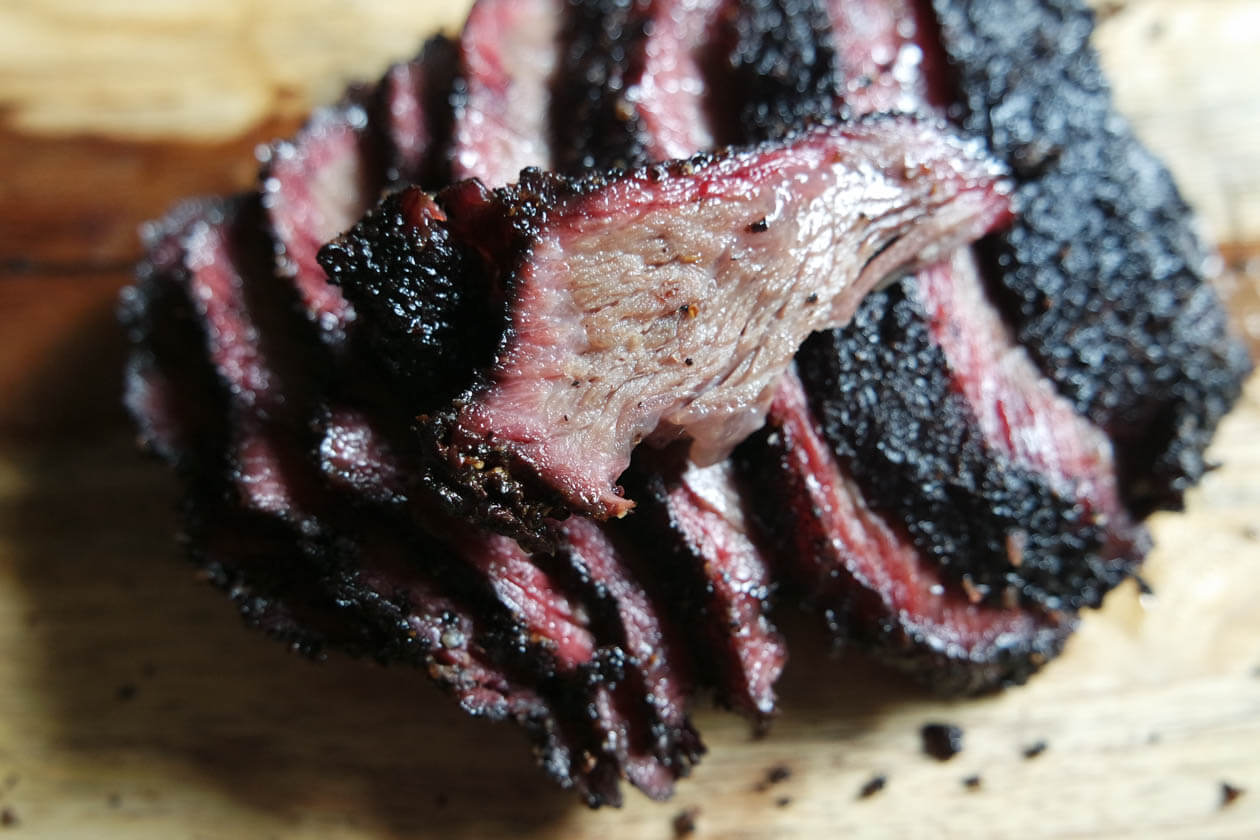These flavorful meat pillows offer a beef flavor and a soft gelatinous consistency. If you enjoy barbecued brisket, you’ll love the taste of smoked beef cheeks. They are commonly used in cooked dishes, like braises, stews, and Barbacoa, a taco filling. Similar to brisket they need to be cooked at temperatures. One advantage is that beef cheeks cook faster than brisket or other traditional smoking meats being ready in five hours.
The term “cheeks” might cause discomfort for some as the thought of eating meat from the head of an animal can be disturbing, although there are those who relish headcheese, jowls, and similar treats. Many incorrectly assume that cheeks are a strange kind of offal, when in fact, they are simply muscle, similar to the various steak cuts taken from other areas of the cow.

The key is to either learn how to properly cut the meat or find a reliable supplier. Cheek meat is widely available in the Southwest since it’s a staple in many Latino recipes. However, the quality can vary, with many meat markets selling it with a lot of tough tissue and excess fat still on it. When I first bought vacuum-sealed cheeks from my local store in Texas, I had to throw away most of the package because it was mainly poor-quality cuts. I understand why this experience might deter some people.
I collaborated with Lone Mountain Wagyu and persuaded them to include cheeks in their selection. Now, they offer exquisitely prepared whole cheeks available for purchase here. Moreover, these cheeks are from 100% fullblood Wagyu, adding an extra touch of luxury.
I experimented several times before I found my preferred way to smoke cheeks, which turned out to be the easiest one. Initially, I wrapped them in butcher’s paper, but those ended up tighter than the ones I didn’t wrap. I also tried cooking them in a foil pan with different liquids, but that ended up being more like stewing. Additionally, I attempted to use foil, but it seemed like an extra step that wasn’t needed.
Smoked beef cheeks hold a place in my heart due to their sticky and tender texture when cooked perfectly. I’ll guide you through my method of preparing beef cheeks using the 3 3 1 technique: smoking them first, then transferring them to a container before wrapping them up for results.
Ingredient:
- 200 grams beef cheek and that’s all (Remember you need to prepare smoker too)
Prepare the Meal:
Here’s everything you need to understand to smoke beef cheeks expertly:
Beef cheeks usually weigh around 200 grams, which’s relatively small, for cuts intended for smoking. However, the high collagen content in beef cheeks helps keep them from drying out.
If you’ve ever savored the flavor of beef cheeks, you’ll surely notice their stickiness thanks to the rich collagen layer found within the cheek. When the cheek is cooked to a temperature, this collagen melts, ensuring the meat remains juicy and acquires that sticky texture that makes this cut so desirable.
I tend to be careful when trimming the cheeks as they are small, and cutting too much could result in losing an amount of meat. However, I always take out any pieces of silver skin, such as the ones illustrated above, as they can be difficult to chew.
The Method:
When it comes to cooked barbecue, you shouldn’t rely heavily on specific cooking times because they can vary a lot each time you cook. Things like the weather, how fatty the meat is, its shape, and the kind of smoker you use can all impact how long it takes to cook. While I’ve cooked beef cheeks times and have generally followed a cooking routine, I’ll also share temperature suggestions to help prevent any disappointment if your cooking ends up taking longer than expected due to unexpected factors.
Prepare your smoker or barbecue to maintain a temperature of 275 degrees Fahrenheit (135 degrees Celsius). It’s okay if the temperature fluctuates slightly. Now, here’s what you should do:
- Smoke the meat for 3 hours. Until the internal temperature reaches around 165 degrees Fahrenheit.
- Place it in a covered container with some liquid. Cook for another 3 hours.
- Tightly wrap it. Keep cooking until it’s tender to the touch, between 205 and 210 degrees Fahrenheit.
Smoke:
Once you’ve prepared the beef cheeks by trimming them, you can add a barbecue seasoning of your liking. Personally, I tend to go for a flavorful rub with an amount of salt and pepper for beef. However, adding a hint of sweetness can enhance the flavor profile of the tender beef cheeks. For instance, you might consider using Perth BBQ School’s Barbecue 101 rub for a paprika-infused taste or opt for our Ruckus rub for a more savory flavor.
I decided to season the cheeks with Meatchurch Bacon BBQ rub for a smoky flavor. I applied a top notch rub, like Perth BBQ Schools Barbecue 101 or Hardcore Carnivore Black to create a crust. Then I placed the cheeks in the smoker for some cooking at around 275 degrees Fahrenheit. It’s okay if the temperature fluctuates slightly; anything between 250 and 300 degrees Fahrenheit works fine and a bit beyond that range should be just fine.
Boat
After smoking the cheeks for three hours, it’s time to wrap them up a technique known as “boating.” This method involves submerging the meat in liquid using aluminum foil or a tray. It helps accelerate the cooking process and keeps the meat juicy by allowing the half to braise while keeping the top exposed to maintain a crispy crust.
At this point, the cheeks should ideally reach a temperature of around 165°F. If they are cooler by than 10°F, you may need to keep them in the smoker for a bit longer. However, if the bark looks good, you can go ahead. Boat them. You have flexibility in choosing your liquid for boating; personally, I like using beer mixed with something like molasses, honey, or brown sugar. In this scenario, I used two bottles of Nail Oatmeal Stout and a cup of molasses.
The piece of collagen running through the center of the cheek gives it a quality. It can pose challenges if not handled carefully. To determine if a cooked cut is done to perfection, it’s best to test for tenderness using a probe rather than solely relying on internal temperature.
Oftentimes, wrapping beef cheeks during cooking helps retain moisture and aids in breaking down the collagen to achieve desired tenderness. Otherwise, you might end up with meat to a rubber band. Simply cover your pan with foil. Let it rest for an hour. Due to the collagen content, beef cheeks typically require a temperature of around 205 210 degrees Fahrenheit. Exercise caution when checking for softness as the meat may feel tender before the collagen is fully softened.
After the beef cheeks are done cooking you have the option to serve them either sliced or shredded – both ways will give you an outcome. While there are ways to enjoy them, in my opinion, tacos are the choice for savoring these juicy bites. Remember, if you slice the beef cheeks and find that the collagen hasn’t completely tenderized, simply return them to the cooking liquid for a little longer.
Bon appétit!
Nutrition Information: (1 serving of 200g smoked beef cheek)
- Calories: Approximately 380-400 kcal
- Protein: 58-62 grams
- Fat: 14-18 grams
- Saturated Fat: 5-6 grams
- Cholesterol: 140-150 mg
- Sodium: 800-1200 mg
- Carbohydrates: 0-2 grams
- Sugars: 0 grams
- Fiber: 0 grams
Please note that the values can vary based on the preparation method and specific ingredients used.
I spent a good bit of my 20’s touring the country playing music. As a teenager, and throughout my 20’s, in between music, I always worked in restaurants, in various capacities. Somewhere in my late 20’s I realized that I was not on the cover of Rolling Stone, as planned, and so, I started thinking about my future and trying to figure out other ways to have an impact, be creative and still live a bit of that rock ‘n roll lifestyle. The restaurant industry provided me with a good bit of those things. And so, I started honing my chops in the kitchen, putting my nose in food lover’s companion, and really started to go somewhere with it.
